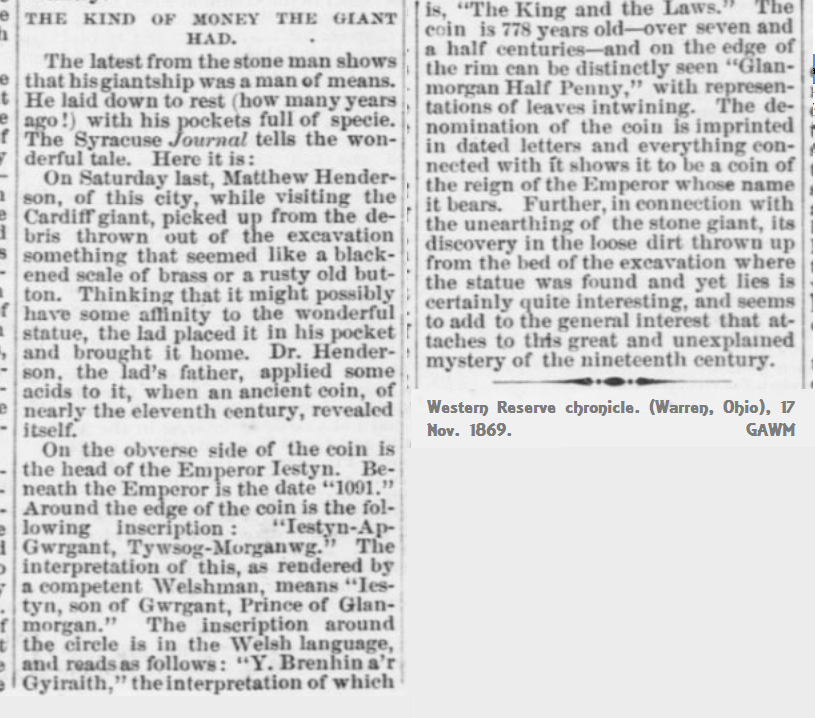Coins found with the Cardiff Giant

KIND OF MONEY THE GIANT HAD.
The latest from the stone man shows that his giantship was a man of means. He laid down to rest (how many years ago!) with his pockets full of specie.
The Syracuse Journal tells the wonderful tale. Here it is:
On Saturday last, Matthew Henderson, of this city, while visiting the Cardiff giant, picked up from the debris thrown out of the excavation something that seemed like a blackened scale of brass or a rusty old button. Thinking that it might possibly have some affinity to the wonderful statue, the lad placed it in his pocket and brought it home. Mr. Henderson, the lad’s father, applied some acids to it, when an ancient coin, of nearly the eleventh century, revealed itself.
On the obverse side of the coin is the head of the Emperor Iestyn. Beneath the Emperor is the date “1091.” Around the edge of the coin is the following inscription: “Iestyn-Ap-Gwrgant, Tywsog-Morganwg.” The interpretation of this, as rendered by a competent Welshman, means “Iestyn, son of Gwrgant, Prince of Glanmorgan.” The inscription around the circle is in the Welsh language and reads as follows: “Y Brenhin a’r Gyfraith,” the interpretation of which is “The King and the Laws.” The coin is 775 years old – over seven and a half centuries – and on the edge of the rim can be distinctly seen “Glanmorgan Half Penny,” with representations of leaves entwining. The denomination of the coin is imprinted in dated letters and everything connected with it shows it to be a coin of the reign of the Emperor whose name it bears.
Further, in connection with the unearthing of the stone giant, its discovery in the loose dirt thrown up from the bed of the excavation where the statue was found and yet lies is certainly quite interesting and seems to add to the general interest that attaches to this great and unexplained mystery of the nineteenth century.
It’s clear that the latest findings from the Cardiff giant excavation only confirm what we already knew: these giants were men of means. It’s fascinating to think that he laid down to rest so many years ago with his pockets full of specie.
But the real excitement comes from the discovery of the ancient coin found among the debris. The interpretation of the Welsh inscription, as rendered by a competent Welshman, reveals the name of the Emperor and the denomination of the coin. It’s incredible to think that this coin is over seven and a half centuries old and yet so well-preserved.
Of course, skeptics will always try to dismiss these findings and cast doubt on the validity of our research. we present this information without taking a stance on its validity. We simply present the facts and let our readers draw their own conclusions.
It’s a shame that the controversy surrounding the Cardiff Giant detracts from the importance of our research into the Mound Builder Giants. Critics seem to forget that this is a field that requires nuanced interpretation of clues and evidence. We will continue to be the voice of the giants and strive to bring their story to light, despite the dismissive and sarcastic comments of skeptics.
- Sights and Scenes on the Western Frontier
- Western Reserve chronicle. (Warren, Ohio), 17 Nov. 1869. Chronicling America: Historic American Newspapers. Lib. of Congress. <http://chroniclingamerica.loc.gov/lccn/sn84028385/1869-11-17/ed-1/seq-1/>